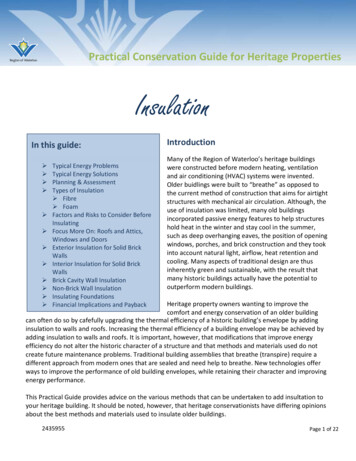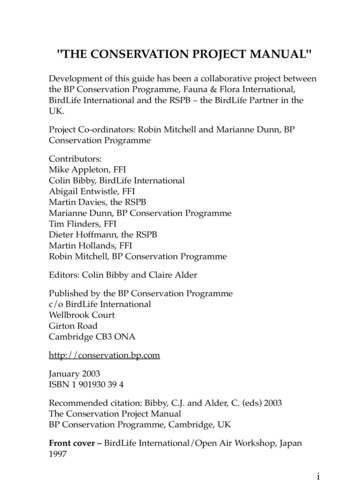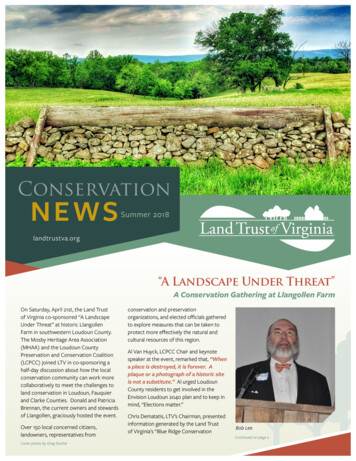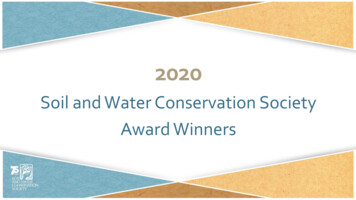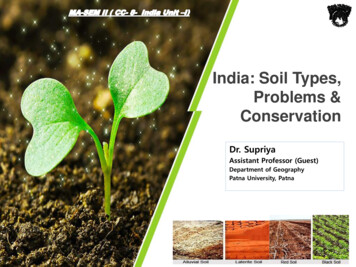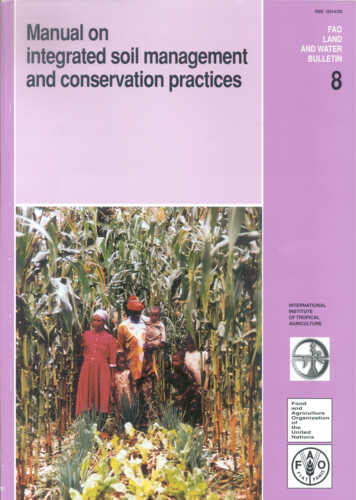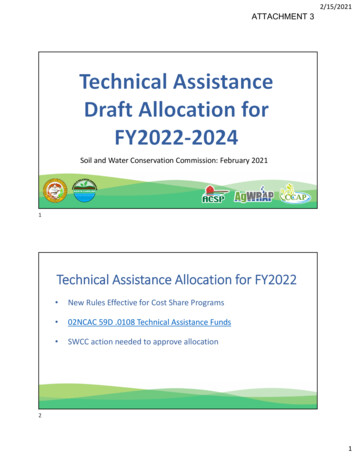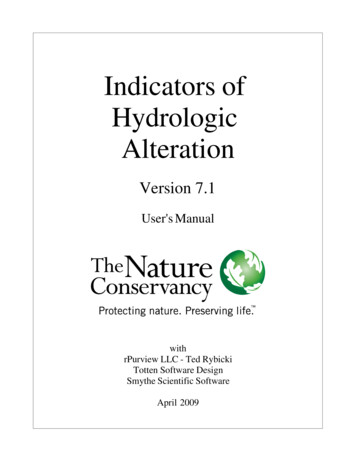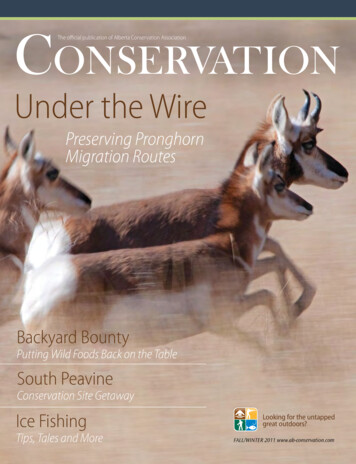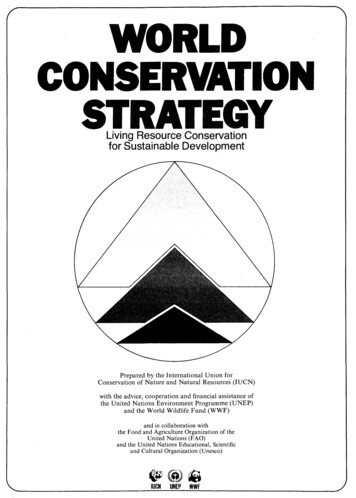
Transcription
WORLDCONSERVATIONSTRATEGYLiving Resource Conservationfor Sustainable DevelopmentPrepared by the International Union forConservation of Nature and Natural Resources (IUCN)with the advice, cooperation and financial assistance ofthe United Nations Environment Programme (UNEP)and the World Wildlife Fund (WWF)and in collaboration withthe Food and Agriculture Organization of theUnited Nations (F AO)and the United Nations Educational, Scientificand Cultural Organization (Unesco) IUCN'1WWF
The SymbolThe circle symbolizes the biosphere-the thincovering of the planet that contains andsustains life. The three interlocking,overlapping arrows symbolize the threeobjectives of conservation:- maintenance of essential ecologicalprocesses and life-support systems;- preservation of genetic diversity;- sustainable utilization of species andecosystems.
WORLDCONSERVATIONSTRATEGYLiving Resource Conservationfor Sustainable DevelopmentPrepared by the International Union forConservation of Nature and Natural Resources (IUCN)with the advice, cooperation and financial assistance ofthe United Nations Environment Programme (UNEP)and the World Wildlife Fund (WWF)and in collaboration withthe Food and Agriculture Organization of theUnited Nations (F AO)and the United Nations Educational, Scientificand Cultural Organization (Unesco)1980 IUCN WWF
The designations employed and the presentation of material inthis publication do not imply the expression of any opinionwhatsoever on the part of IUCN, UNEP or WWF concerning thelegal status of any country, territory, city or area or of its authorities,or concerning the delimitation of its frontiers or boundaries.Copyright IUCN-UNEP-WWF 1980All rights reservedFirst published 1980Second printing 1980ISBN 2-88032-104-2 (Bound)ISBN 2-88032-101-8 (Pack)
WORLD CONSERVATION STRATEGYContentsPreamble and GuideForewordPreface and acknowledgementsGuide to the World Conservation StrategyExecutive SummaryI·IIIVVIWorld Conservation Strategy1.Introduction: living resource conservation for sustainable·developmentThe' objectives of conservation and requirements for theirachievement2.Maintenance of essential ecological processes and life-supportsystems3. Preservation of genetic diversity4. Sustainable utilization of species and ecosystems5. Priority requirements: ecological processes and life-supportsystems6. · Priority requirements: genetic diversity7. Priority requirements: sustainable utilizationPriorities for national action8.9.A framework for national and subnational conservation strategiesPolicy making and the integration of conservation anddevelopment10 . Environmental planning and rational use allocation11. Improving the capacity to manage: legislation and organization12. Improving the capacity to manage: training and research13. Building support for conservation: participation and education14. Conservation-based rural developmentContinued overleaf
ContentsPriorities for international action15. International action: law and assistance16. Tropical forests and drylands17. A global programme for the protection of genetic resource areas18. The global commons19. Regional strategies for international river basins and seas20. Towards sustainable developmentMap Section1.2.3.4.5.Tropical forestsDeserts and areas subject to desertificationPriority biogeographical provinces of the land for theestablishment of protected areasInternational river basinsMajor consumers and exporters of seafood and gainers of largefisheries
WORLD CONSERVATION STRATEGYForevvord. Human beings, in their quest for economic development and enjoyment of the riches ofnature, must come to terms with the reality of resource limitation· and the carryingcapacities of ecosystems·, and must take acc unt of the needs of future generations.This is the message of conservation. For ifthe object of development is to provide forsocial and economic welfare, the object of conservation is to ensure Earth's capacityto sustain development and to support all life.Two features characterize our time. The first is the almost limitless capacity of humanbeings for building and creation, matched by equally great powers of destruction andannihilation. The escalating needs of soaring numbers have often driven people to takea short-sighted approach when exploiting natural resources. The toll of this approachhas now become glaringly apparent: a long list of hazards and disasters, includingsoil erosion, desertification, loss of cropland, pollution, deforestation, ecosystem degradation and destruction, and extinction of species and varieties. This situationunderlines the need for conservation, comprising the ecologically sound management·of productive systems and the maintenance of their viability and versatility.The second is the global interrelatedness of actions, with its corollary of global responsibility. This in turn gives rise to the need for global strategies both for development and for conservation of nature and natural resources. The international community addresses the former through the development decades and associated enterprises sponsored by the United Nations, and is now addressing the latter through theWorld Conservation Strategy. presented in this pack.The World Conservation Strategy provides both an intellectual framework and practical guidance for the conservation actions necessary. It cails for global coordinated efforts backed by will and determination, for concerted action at national andinternational levels, and for global solidarity to implement its programmes. Worldwide action to give practical effect to this strategy is a necessary complement to aworld-wide programme for rational development of the resources of our planet.Development and conservation are equally necessary for our survival and for the discharge of our responsibilities as trustees of natural resources for the generations tocome.IUCN, UNEP and WWF have joined hands in the preparation of the present WorldConservation Strategy, and will continue to coordinate their endeavours in supportof its implementation.Mohamed KassasPresidentIUCNMostafa K. TolbaExecutive DirectorUNEPJohn H. LoudonPresidentWWFI
WORLD CONSERVATION STRATEGYPreface and acknowledgelllentsThe World Conservation Strategy (WCS) was commissioned by the United NationsEnvironment Programme (UNEP) which together with the World Wildlife Fund(WWF) provided the financial support for its preparation and contributed to theevolution of its basic themes and structure. IUCN is grateful to both organizationsfor all their support. While the WCS has been prepared by IUCN and primarilyreflects IUCN's views and approaches it is intended that the Strategy represent a consensus of policy on conservation efforts in the context of world development. To thisend the final draft was submitted to the Food and Agriculture Organization of theUnited Nations (F AO) and the United Nations Educational, Scientific and CulturalOrganization (Unesco), as well as to UNEP and WWF, and all four organizationscarefully reviewed it and made significant contributions to it. The WCS is endorsedby the Ecosystem Conservation Group (ECG) the members of which are UNEP,FAO, Unesco and.IUCN.The WCS, as the product of an extremely thorough consultation process, inevitablyreflects a compromise: among conservationists, who may differ on the relative importance of particular ecosystems, species, issues and measures; and between conservationists and the practitioners of development, who may differ in their emphasis onmaintenance on the one hand and production on the other. The document also sharesthe limitations of every global analysis: it is obliged to aggregate and simplify a hostof diverse local phenomena and to ignore a host of local problems. Knowledge of theworld is so patchy that global generalizations are particularly prone to error. Thesedra whacks are recognized; but they are considered less important than the need topresent a statement of agreed conservation requirements and priorities, aroundwhich conservationists and development practitioners alike could rally, and to adopta perspective unconfined by the boundaries that separate but do not insulate nationfrom nation, sector from sector, or interest from interest.There is a parallel, paperback version of the World Conservation Strategy for thegeneral reader. The paperback differs from the version in this pack in style and layoutand in providing both a fuller account of the importance of living resource conservation and a more detailed description of the priority conservation issues. The paperback devotes less space than the pack to the organizational aspects of conservation and its integration with development. Its purpose is to make more people awareof the vital importance of living resource conservation.As a supplement to the two versions of the WCS, a Sourcebook will be publishedover several years in a number of volumes-on species, on ecosystems of the land,II
fresh waters and the sea, and on issues and measures. The Sourcebook will providemore detailed information than can be contained in the Strategy, and a basis for theStrategy's further development. The WCS is intended to be an evolving effort andis expected to be up-dated and improved from time to time, in response to newknowledge, better understanding, changes in perception and values, and conservationprogress as a result of the Strategy's implementation. For it is strongly hoped thatgovernments, nongovernmental organizations and intergovernmental bodies will bequick to carry out the relevant recommendations. The members of the EcosystemConservation Group and WWF are ready to give whatever help they can within thelimits of available resources, should their assistance be requested.Many governments, nongovernmental organizations and individuals from bothdeveloped and developing countries have participated in the preparation of theStrategy. IUCN's membership currently consists of more than 450 government agencies and conservation organizations in over 100 countries. These members were firstpolled for their views on conservation priorities. Subsequently two drafts of the WCSwere sent to them for comment, as well as to I UCN's Commissions of more than 700scientists and other experts on ecology, threatened species, protected areas, environmental planning, environmental policy, law and administration and environmental education. The individuals concerned are too numerous to name here, butthe assistance of each is gratefully acknowledged.Special thanks, however, should go to the members of the four panels that revieweddrafts of the WCS: Emmanuel O.A. Asibey, Mona Bjorklund, Cecilia de Blohm,Mario A. Boza, William G. Conway, Sylvia Earle, Charles de Haes, N.D. Jayal,Mohamed Kassas, Ashok Khosla, F. Wayne King, P.H.C. Lucas, Duncan Poore,G. Carleton Ray, Mats Segnestam, Thomas B. Stoel Jr., Maurice F. Strong, and LeeM. Talbot. The generous contribution of their time and expertise was invaluable.Patrick Virolle who devised the symbol and designed this pack, Dounia Morganwho translated the text into French, and the many IUCN secretaries who at varioustimes typed one draft or another also deserve particular appreciation.Robert Allen, as compiler and editor of the Strategy, guided it through the fourworking drafts and prepared the present text. His contribution has been central tothe whole endeavour.David A. MunroDirector GeneralIUCNIII
WORLD CONSERVATION STRATEGYGuide to the World Conservation StrategyThe aimThe aim of the World Conservation Strategy is to help advance the achievement ofsustainable development through the conservation of living resources. The Strategy:1. explains the contribution of living resource conservation to human survival and tosustainable development;2. identifies the priority conservation issues and the main requirements for dealingwith them;3. proposes effective ways for achieving the Strategy's aim.The Strategy is intended to stimulate a more focussed approach to living resourceconservation and to provide policy guidance on how this can be carried out. Itconcentrates on the main problems directly affecting the achievement of conservation's objectives; and on how to deal with them through conservation. In particular,the Strategy identifies the action needed both to improve conservation efficiency andto integrate conservation and development.The usersThe Strategy is intended chiefly for three groups of user (none of which is wholly separate from the others):1. Government policy makers and .their advisers. Few governments have the financial and technical resources to ·address' all of the problems of living resource conservation at once. Therefore they need to know what needs to be done first. Accordingly, the Strategy both recommends ways of overcoming the main obstaclesto conservation and provides guidance on what action is most important. TheStrategy is relevant to any level of government with significant responsibilities forplanning and managing the use of living resources.2. Conservationists and others directly concerned with living resources. For thisgroup, the Strategy indicates those areas where conservation action is mosturgently needed and where it is likely to yield the greatest and most lasting results.It also proposes ways in which conservation can participate more effectively in thedevelopment process, thereby increasing the likelihood of its being positivelyreceived by the development community and of helping to ensure that development is sustainable.3. Development practitioners, including aid agencies, industry and commerce, andtrade unions. For this group the Strategy demonstrates that conservation im-IV
proves the prospects of sustainable development and proposes ways of integratingconservation into the development process. It also attempts to identify those areaswhere the interests of conservation and of development are most likely to coincideand therefore where a closer partnership between the t
soil erosion, desertification, loss of cropland, pollution, deforestation, ecosystem deg radation and destruction, and extinction of species and varieties. This situation underlines the need for conservation, comprising the ecologically sound management· of productive systems and the maintenance of their viability and versatility. The second is the global interrelatedness of actions, with .
